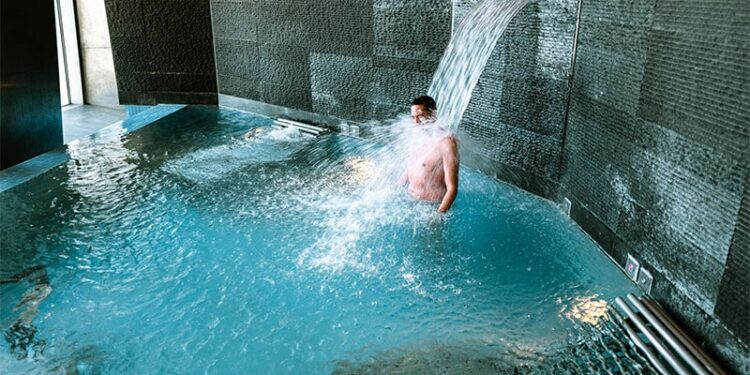Balneotherapy combines the use of mineral or thermal waters with physical exercises performed in water for therapeutic purposes. “This treatment is always carried out under the supervision of physicians specializing in thermal medicine and physiotherapists,” said Natàlia García Giralt, PhD, a geneticist and balneotherapy expert at the Hospital del Mar Research Institute (HMRIB) in Barcelona, Spain, and the Biomedical Network Research Centre (CIBER) on Frailty and Healthy Aging in Madrid, in an interview with Univadis Spain, a Medscape Network platform.
Balneotherapy is based on the chemical, physical, and thermal properties of mineral-medicinal waters. Depending on the source, these waters may contain elements such as sulfur, iron, calcium, sodium, bicarbonate, radon, or magnesium. They are typically applied topically for therapeutic, preventive, or rehabilitative purposes and may offer anti-inflammatory, analgesic, muscle-relaxing, or circulation-enhancing effects.
This approach is widely supported in the fields of physical medicine and rehabilitation, particularly for conditions such as rheumatologic diseases, osteoarthritis, fibromyalgia, dermatologic conditions, and some respiratory and neurologic disorders.
“In general, balneotherapy is effective in managing symptoms like fatigue, pain, and anxiety associated with these conditions,” said García Giralt. “However, it’s important to clarify that the goal is symptom relief and improved quality of life — it is not a curative treatment, particularly given that the root causes of many of these conditions remain unclear.”
Scientific Basis
The therapeutic benefits of balneotherapy arise from three main factors:
- Chemical composition: Depending on the mineral content and method of application, thermal waters may have anti-inflammatory, analgesic, immunomodulatory, and keratolytic effects.
- Water temperature: Warm thermal waters promote vasodilation, muscle relaxation, and improved circulation. In contrast, cold thermal waters are often used in acute phases to reduce inflammation or in vascular therapies.
- Physical properties: The buoyancy and hydrostatic pressure of water reduce joint load and support movement, which is especially beneficial in functional rehabilitation.
Balneotherapy for Long COVID
Long COVID is associated with persistent symptoms such as fatigue, musculoskeletal pain, and generalized anxiety — areas where balneotherapy has shown promise. “Prior evidence suggested that balneotherapy might help alleviate symptoms in patients with long COVID,” said García Giralt.
To test this hypothesis, a randomized, prospective, open-label clinical trial was launched in 2022, after the most severe phase of the COVID pandemic had passed. The study was led by researchers from HMRIB, CIBER’s Frailty and Healthy Aging, and CIBER’s Infectious Diseases Division, in partnership with the municipality of Caldes de Montbui.
The findings, published in BMC Complementary Medicine and Therapies, showed that participants undergoing thermal water exercise therapy were twice as likely to experience symptom improvement compared with those in the control group who did not receive balneotherapy.
Trial Design
Participants were recruited through the multidisciplinary Post-COVID Unit at Hospital del Mar or via a primary care center in Barcelona. The City Council of Caldes de Montbui also supported recruitment through its website. Interested individuals underwent an initial clinical screening to determine eligibility.
- Inclusion criteria: Adults aged 18 or older with a confirmed diagnosis of long COVID.
- Exclusion criteria: Patients with preexisting conditions that could mimic or overlap with long COVID symptoms — such as fibromyalgia, chronic fatigue syndrome, chronic pain, or generalized anxiety/depression requiring pharmacologic treatment — were excluded. Additional exclusions included chronic diseases requiring active treatment (eg, cancer, chronic viral infections, systemic autoimmune conditions, epilepsy, or poorly controlled endocrine disorders) and conditions that could interfere with therapy (eg, water phobia, incontinence, advanced venous insufficiency, significant physical disability, or symptomatic hypotension). Patients with anemia, stage 4 or higher chronic kidney disease, liver failure, or thyroid dysfunction were also excluded.
Of the 129 individuals initially screened, 98 (84% women; mean age, 48 years) were enrolled. García Giralt emphasized that the high proportion of women participants should not bias interpretation of the results, as prior research shows women — especially younger and middle-aged individuals — have been disproportionately affected by long COVID.
Of the 98 participants enrolled in the clinical trial, 51 were assigned to the intervention group. These individuals received 12 sessions of balneotherapy over the course of 1 month. Each session included a structured sequence: Breathing exercises using thermal water, circulatory showers to stimulate blood flow, 15 minutes of light physical activity, and 15-20 minutes of relaxation in a thermal pool.
The control group, which included 47 participants, did not receive any balneotherapy intervention. Four participants in the intervention group withdrew — two due to adverse events associated with treatment and two due to unrelated injuries. In the control group, four participants did not complete follow-up assessments. The final analysis included 47 individuals in the intervention group and 43 in the control group.
At baseline, both groups reported similar symptoms, including fatigue, pain, respiratory difficulties, anxiety, depression, and memory issues.
Key Outcomes
Data were collected using a battery of assessments at three timepoints: the initial visit (baseline), at the end of the balneotherapy program (or 1 month post-baseline for the control group), and 1 month after completing balneotherapy (or 2 months post-baseline for the control group).
The most notable improvements were seen in fatigue and pain, with 75% of participants in the intervention group reporting symptom reduction. These benefits persisted beyond the end of the treatment period. More than half of the participants also reported improvements in anxiety levels and sleep quality.
“This is understandable, as beyond the direct benefits of balneotherapy, participants had the opportunity to share their experiences and feel heard — something many had not encountered in clinical settings, where physicians often struggled to understand their condition,” explained García Giralt. “Lower anxiety levels also helped them relax and sleep better.” However, she noted that the improvements in anxiety and sleep did not persist 1 month after the sessions ended.
In contrast, no significant improvements were observed in neurocognitive symptoms, such as memory loss. The intervention was associated with minimal side effects.
“For all these reasons, many participants chose to continue balneotherapy after the trial concluded,” added García Giralt. “The spa also supported this by offering follow-up sessions at a significantly reduced cost compared to its usual rates.”
Coverage Debate
Balneotherapy has demonstrated benefits across a variety of conditions associated with musculoskeletal pain, fatigue, depression, and anxiety.
However, balneotherapy remains a costly intervention, and daily access to spa facilities is financially out of reach for many patients — particularly those on medical leave, whose income is already reduced, noted García Giralt.
Given this reality, the question arises whether national health systems should intervene and provide full or partial funding for such therapies. According to García Giralt, the answer is clear: “Yes, public healthcare systems or government agencies should fund balneotherapy. It has been shown to benefit health and improve quality of life in patients with conditions like long COVID, fibromyalgia, osteoarthritis, and rheumatic diseases. Just as medication costs are subsidized to ensure universal access, balneotherapy should be treated similarly. From an economic standpoint, supporting this therapy could potentially lower pharmaceutical expenditures for these conditions.”
This story was translated from Univadis Spain.
Source link : https://www.medscape.com/viewarticle/balneotherapy-shows-promise-post-covid-fatigue-2025a1000h5q?src=rss
Author :
Publish date : 2025-06-26 11:49:00
Copyright for syndicated content belongs to the linked Source.









